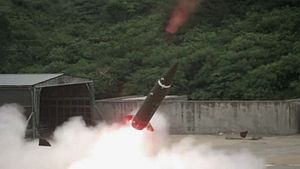The Republic of Korea Army will aim to deploy two new short-range ballistic missile system, known as the Korea Tactical Surface-to-Surface Missile (KTSSM) later this year, Defense News reports.
“The Ministry of National Defense has approved a plan to create an artillery brigade under a ground forces operations command to be inaugurated in October. The plan is to be reported to President Moon Jae-in next month as part of the ‘Defense Reform 2.0’ policy,” a source told Defense News.
“The brigade’s mission is fairly focused on destroying North Korea’s long-range guns more rapidly and effectively, should conflict arise,” the source added, according to the report.
Two variants of the KTSSM—the KTSSM-I and KTSSM-II—will arm a new South Korean counter-artillery brigade by October this year, the report notes.
The KTSSM missiles were developed as a rapid-response missile to enable counterbattery fire against North Korean artillery emplacements, multiple rocket launch systems (MRL), and short-range ballistic missiles, including close-range solid-fuel missiles like the KN02 Toksa.
The KTSSM missiles are designed to allow the South Korean military to effectively neutralize scores of North Korean artillery and ballistic missile launchers north of the demilitarized zone at the start of a conflict.
Because of the difficulties associated with locating these systems before they are used against South Korea’s capital city, Seoul, in wartime, the KTSSM systems would play a rapid retaliation role.
With a range of more than 120 kilometers, KTSSM-I can range most of North Korea’s conventional artillery systems. Longer-range systems, like ballistic missiles and the KN09 300mm MRL, will be capable of firing at South Korean targets from farther inside North Korea’s territory, but South Korea has other precision strike ballistic missiles to hold these targets at risk.
In a conflict, the Republic of Korea Air Force and U.S. Air Force would also be deployed to strike at any ballistic missiles that may be capable of launching nuclear weapons.
According to South Korean sources, KTSSM boasts a circular error probable of just two meters, making it a highly precise missile. The system is designed to have some capability to penetrate hardened targets.
South Korea’s Agency for Defense Development released footage last year, showing one of the missiles striking an underground facility.
Countering North Korea’s artillery capabilities has long concerned South Korean defense planners. North Korea has scores of self-propelled and towed artillery guns, which would be capable of barraging Seoul, inflicting massive casualties in the opening hours of a conflict.
Beyond counterbattery fire, South Korean officials are exploring more exotic options for certain North Korean platforms.
Last year, South Korea’s Joint Chiefs of Staff told lawmakers in the country that they are studying the feasibility of developing a new type of interceptor that would be specifically designed to target incoming rocket artillery and long-range artillery fire.

































